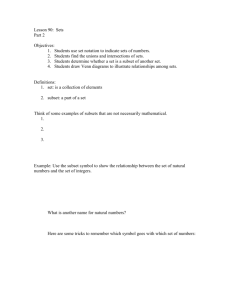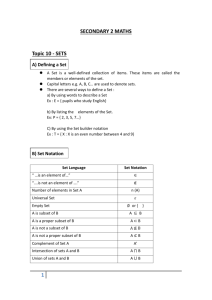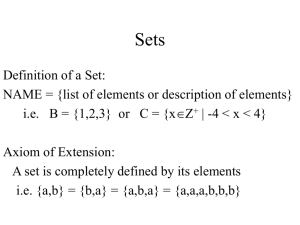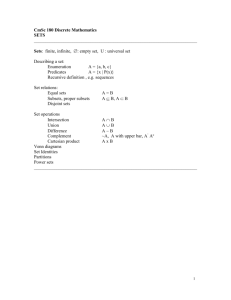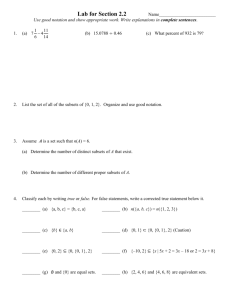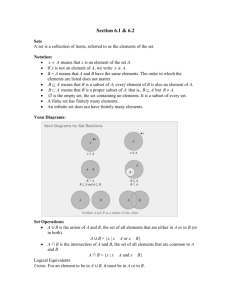CmSc 175 Discrete Mathematics Lesson 10: SETS Sets
advertisement
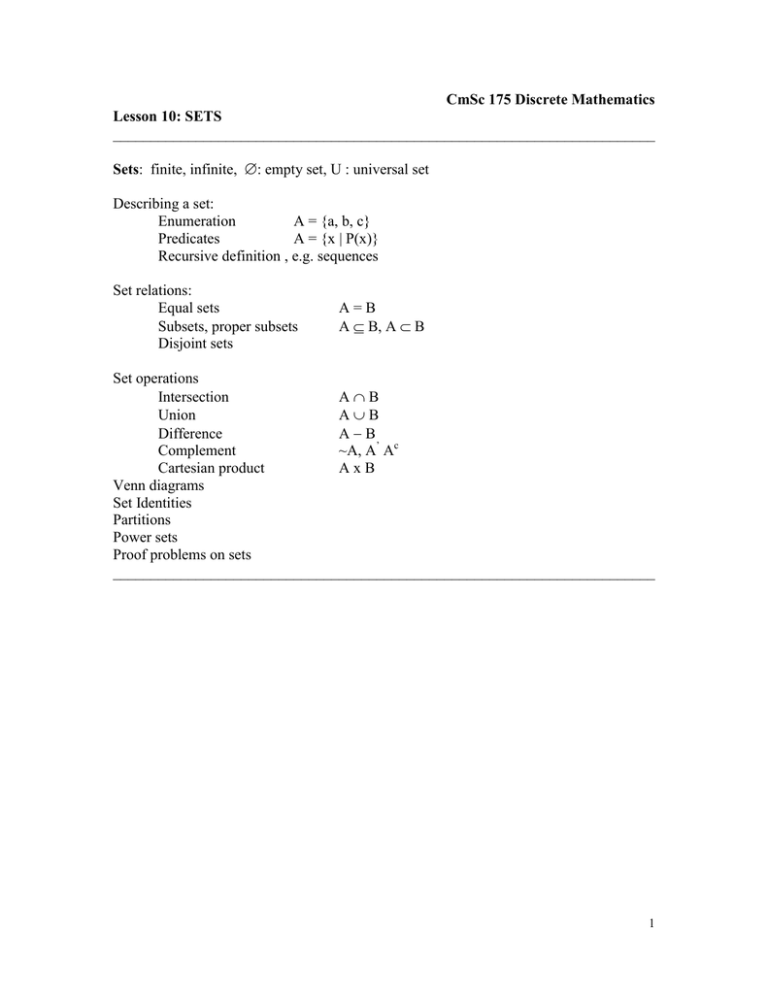
CmSc 175 Discrete Mathematics
Lesson 10: SETS
________________________________________________________________________
Sets: finite, infinite, : empty set, U : universal set
Describing a set:
Enumeration
A = {a, b, c}
Predicates
A = {x | P(x)}
Recursive definition , e.g. sequences
Set relations:
Equal sets
Subsets, proper subsets
Disjoint sets
A=B
A B, A B
Set operations
Intersection
AB
Union
AB
Difference
AB
Complement
~A, A’ Ac
Cartesian product
AxB
Venn diagrams
Set Identities
Partitions
Power sets
Proof problems on sets
________________________________________________________________________
1
1. Introduction
Set: any collection of objects (individuals)
Naming sets: A, B, C,….
Members of a set: the objects in the set
Naming objects: a, b, c, ….
Notation: Let A be a set of 3 letters a, b, c.
We write A = {a, b, c}
a is a member of A, a is in A, we write a є A
d is not a member of A, we write d A
Important:
1. {a} a
{a} - a set consisting of one element a.
a - the element itself
2. A set can be a member of another set:
B = { 1, 2, {1}, {2}, {1,2}}
Finite sets: finite number of elements
Infinite sets: infinite number of elements
Cardinality of a finite set A: the number of elements in A: #A, or |A|
Describing sets:
a. by enumerating the elements of A:
for finite sets: {red, blue, yellow}, {1,2,3,4,5,6,7,8,9,0}
for infinite sets we write: {1,2,3,4,5,….}
b. by property, using predicate logic notation
Let P(x) is a property, D - universe of discourse
The set of all objects in D, for which P(x) is true, is :
A = {x | P(x)}
we read: A consists of all objects x in D such that P(x) is true
c. by recursive definition, e.g. sequences
2
Examples:
1. The set of the days of the week:
{Sunday, Monday, Tuesday, Wednesday, Thursday, Friday, Saturday}
2. The set of all even numbers :
{ x | even(x) }
{ 2,4,6,8,….}
3. The set of all even numbers, greater than 100:
{ x | even(x) x > 100}
{ 102, 104, 106, 108,….}
4. The set of integers defined as follows:
a1 = 1, an+1 = an + 2 (the odd natural numbers)
Universal set:
Empty set:
U - the set of all objects under consideration
Ø set without elements.
2. Relations between sets
2.1. Equality
Let A and B be two sets.
We say that A is equal to B, A = B if and only if they have the same members.
Example:
A = {2,4,6}, B = {2,4,6} A = B
A = {a, b, c}, B = {c, a, b} A = B
A = {1,2,3}, B = {1,3,5}, A ≠ B
Written in predicate notation:
A = B if and only if x , x є A ↔ x є B
3
2.2. Subsets
The set of all numbers contains the set of all positive numbers. We say that the set of all
positive numbers is a subset of the set of all numbers.
Definition: A is a subset of B if all elements of A are in B. However B may contain
elements that are not in A
Notation: A B
Formal definition:
A B if and only if x , x єA x є B
Example: A = {2,4,6}, B = {1,2,3,4,5,6}, A B
Definition: if A is a subset of B, B is called a superset of A.
Other definitions and properties:
a. If A B and B A then A = B
If A is a subset of B, and B is a subset of A, A and B are equal.
b. Proper subsets: A is a proper subset of B, A B, if and only if A is a subset of B and
there is at least one element in B that is not in A.
A B iff x , x є A x є B x , x є B x A
The above expression reads:
A is a proper subset of B if and only if all x in A are also in B and there is an
element x in B that is not in A.
iff means if and only if
The empty set Ø is a subset of all sets.
All sets are subsets of the universal set U.
4
2.3. Disjoint sets
Definition: Two sets A and B are disjoint if and only if they have no common elements
A and B are disjoint if and only if
i.e. x, x A V x B
~x, (x є A ) (x є B)
If two sets are not disjoint they have common elements.
Picturing sets: Venn diagrams - used to represent relations between sets
B
A is a (proper) subset of B
A
All elements in the set A are
also elements in the set B
Disjoint sets
A
B
A
B
Not disjoint sets
5
3. Operations on sets
3.1. Intersections
The set of all students at Simpson and the set of all majors in CS have some elements in
common - the set of all students in Simpson that are majoring in CS. This set is formed as
the intersection of all students in CS and all students at Simpson.
Definition: Let A and B are two sets. The set of all elements common to A and B is
called the intersection of A and B
Notation: A B
Formal definition:
A B = {x | (x є A ) (x є B)}
Venn diagram:
B
A
Example: A = {2,4,6}, B = {1,2,5,6}, A B = {2,6}
Other properties:
A B
A,
A B B
The intersection of two sets A and B is a subset of A, and a subset of B
A Ø = Ø The intersection of any set A with the empty set is the empty set
A U = A The intersection of any set A with the universal set is the set A itself.
Intersection corresponds to conjunction in logic.
Let A = {x | P(x)}, B = {x | Q(x)}
A B = {x | P(x) Q(x)}
6
3. 2. Unions
The set of all rational numbers and the set of all irrational numbers taken together form
the set of all real numbers - as a union of the rational and irrational numbers.
All classes at Simpson consist of students. If we take the elements of all classes, we will
get all students - as the union of all classes.
Definition: The union of two sets A and B consists of all elements that are in A
combined with all elements that are in B.
(note that an element may belong both to A and B)
Notation: A B
Formal definition:
A B = {x | (x є A) V (x є B)}
Venn diagram:
B
A
E
Example: A = {2,4,6,8,10}, B = {1,2,3,4,5,6}, A B = { 1,2,3,4,5,6,8,10}
A B contains all elements in A and B without repetitions.
Other properties of unions:
A
A B
B AB
A is a subset of the union of A and B,
B is a subset of the union of A and B
A Ø = A The union of any set A with the empty set is A
A U = U The union of any set A with the universal set E is the universal set.
Union corresponds to disjunction in logic.
Let A = {x | P(x)}, B = {x | Q(x)}
A B = {x | P(x) V Q(x)}
7
3.3. Differences
The books I have at home are the books that are mine and the books I've taken from the
library. When I return the books to the library, only my own books will remain.
Thus my own books at home form a set that is the difference between all books at home
and library books
Definition: Let A and B be two sets. The set A - B, called the difference between A and
B, is the set of all elements that are in A and are not in B.
Notation: A – B or A \ B
Formal definition:
A – B = { x | ( x є A) ( x B)}
Venn diagram:
A
Example: A = {2,4,6}, B = {1, 5,6},
A–Ø =A
A–U =Ø
B
A - B = {2,4}
The difference between A and the empty set is A
The difference between A and the universal set is the empty set.
3.4. Complements
Definition: Let A be a set. The set of all objects within the universal set that are not in A,
is called the complement of A.
Notation: ~A
Formal definition:
~A = {x | x A }
Venn diagram:
A
~A
8
Problems on set operations
1. Let A = {1,3,4,5}, B = {3,5,7,8}
AB=
AB=
A–B =
Let E = {1, 2, 3, 4, 5, 6, 7, 8, 9, 0}
~A =
~B =
2. Let the universal set be the set R of all real numbers and let
A = {x R | -5 x < 3}, B = { x R | -1 < x 9}.
Find each of the following:
AB=
AB=
~A
=
~B
=
~A ~B =
~A ~B =
~(A B) =
~(A B) =
3. Let E be the set of all student in Simpson College.
A: all CS majors
B: all Math majors
C: all female students
D: all senior students.
Write the expressions for:
a. All female students that are both CS and Math majors
b. All male students and all Math senior students.
c. All CS students that are not senior students
9
Venn diagrams
4. Let A, B and C are sets represented below:
Shade the regions corresponding to:
(A B) C
A (B C)
A - (B C)
~(A B)
10

